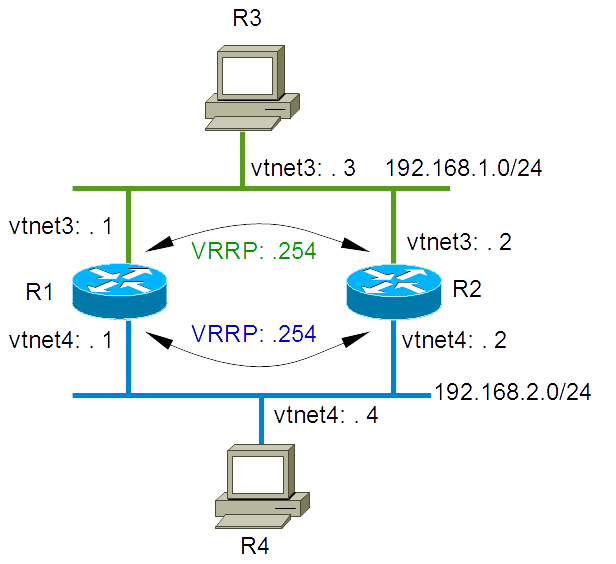Table of Contents
Simple VRRP lab
Network Diagram
Starting the lab
More information on these BSDRP lab scripts available on How to build a BSDRP router lab.
Example with the bhyve lab script:
# ./BSDRP-lab-bhyve.sh -i /usr/obj/BSDRP.amd64/BSDRP-1.61-full-amd64-vga.img -n 4 -l 2 vmm module not loaded. Loading it... nmdm module not loaded. Loading it... if_tap module not loaded. Loading it... BSD Router Project (http://bsdrp.net) - bhyve full-meshed lab script Setting-up a virtual lab with 4 VM(s): - Working directory: /tmp/BSDRP - Each VM have 1 core(s) and 256M RAM - Switch mode: bridge + tap - 2 LAN(s) between all VM - Full mesh Ethernet links between each VM VM 1 have the following NIC: - vtnet0 connected to VM 2. - vtnet1 connected to VM 3. - vtnet2 connected to VM 4. - vtnet3 connected to LAN number 1 - vtnet4 connected to LAN number 2 VM 2 have the following NIC: - vtnet0 connected to VM 1. - vtnet1 connected to VM 3. - vtnet2 connected to VM 4. - vtnet3 connected to LAN number 1 - vtnet4 connected to LAN number 2 VM 3 have the following NIC: - vtnet0 connected to VM 1. - vtnet1 connected to VM 2. - vtnet2 connected to VM 4. - vtnet3 connected to LAN number 1 - vtnet4 connected to LAN number 2 VM 4 have the following NIC: - vtnet0 connected to VM 1. - vtnet1 connected to VM 2. - vtnet2 connected to VM 3. - vtnet3 connected to LAN number 1 - vtnet4 connected to LAN number 2 For connecting to VM'serial console, you can use: - VM 1 : cu -l /dev/nmdm1B - VM 2 : cu -l /dev/nmdm2B - VM 3 : cu -l /dev/nmdm3B - VM 4 : cu -l /dev/nmdm4B
Special notes for VLAN user
Do not uses the default interface vlan name assignment (like “igb0.10”), because the underlying tool (netgraph) doesn't support interface name that includes a dot.
Configuring Routers
Router 1 (R1)
sysrc hostname=R1 \ ifconfig_vtnet3="inet 192.168.1.1/24" \ ifconfig_vtnet4="inet 192.168.2.1/24" \ freevrrpd_enable=YES cat <<EOF > /usr/local/etc/freevrrpd.conf [VRID] serverid = 1 interface = vtnet3 # This router is the master priority = 101 addr = 192.168.1.254/24 # We want that this state is dependant with the state of vrid 2 vridsdep = 2 password = vrid1 [VRID] serverid = 2 interface = vtnet4 # This router is the master priority = 101 addr = 192.168.2.254/24 password = vrid2 # We want that this state is dependant with the state of vrid 1 vridsdep = 1 EOF service netif restart service freevrrpd start config save
Router 2 (R2)
sysrc hostname=R2 \ ifconfig_vtnet3="inet 192.168.1.2/24" \ ifconfig_vtnet4="inet 192.168.2.2/24" \ freevrrpd_enable=YES cat <<EOF > /usr/local/etc/freevrrpd.conf [VRID] serverid = 1 interface = vtnet3 # This router is the backup priority = 100 addr = 192.168.1.254/24 # We want that this state is dependant with the state of vrid 2 vridsdep = 2 password = vrid1 [VRID] serverid = 2 interface = vtnet4 # This router is the backup priority = 100 addr = 192.168.2.254/24 password = vrid2 # We want that this state is dependant with the state of vrid 1 vridsdep = 1 EOF service netif restart service freevrrpd start config save
Router 3 (R3)
sysrc hostname=R3 \ ifconfig_vtnet3="inet 192.168.1.3/24" \ defaultrouter="192.168.1.254" \ gateway_enable=NO \ ipv6_gateway_enable=NO service netif restart service routing restart config save
Router 4 (R4)
sysrc hostname=R4 \ ifconfig_vtnet4="inet 192.168.2.4/24" \ defaultrouter="192.168.2.254" \ gateway_enable=NO \ ipv6_gateway_enable=NO service netif restart service routing restart config save
Checking configuration
VRRP state
On R1:
[root@R1]~# grep vrrp /var/log/messages Nov 5 11:37:15 R1 freevrrpd[1177]: launching daemon in background mode Nov 5 11:37:15 R1 freevrrpd[1178]: initializing threads and all VRID Nov 5 11:37:15 R1 freevrrpd[1178]: reading configuration file /usr/local/etc/freevrrpd.conf Nov 5 11:37:15 R1 freevrrpd[1178]: monitored circuits engine initialized Nov 5 11:37:16 R1 freevrrpd[1178]: server state vrid 1: backup Nov 5 11:37:17 R1 freevrrpd[1178]: server state vrid 2: backup Nov 5 11:37:20 R1 freevrrpd[1178]: server state vrid 1: master Nov 5 11:37:21 R1 freevrrpd[1178]: server state vrid 2: master
R1 is VRRP master for vrid 1 and 2.
On R2:
[root@R2]~# grep vrrp /var/log/messages Nov 5 11:41:37 R2 freevrrpd[2091]: launching daemon in background mode Nov 5 11:41:37 R2 freevrrpd[2092]: initializing threads and all VRID Nov 5 11:41:37 R2 freevrrpd[2092]: reading configuration file /usr/local/etc/freevrrpd.conf Nov 5 11:41:37 R2 freevrrpd[2092]: monitored circuits engine initialized Nov 5 11:41:38 R2 freevrrpd[2092]: server state vrid 1: backup Nov 5 11:41:39 R2 freevrrpd[2092]: server state vrid 2: backup
R2 is the VRRP backup for vrid 1 and 2.
Forwarding and ARP entry
Pinging R4 from R3:
[root@R3]~# ping 192.168.2.4 PING 192.168.2.4 (192.168.2.4): 56 data bytes 64 bytes from 192.168.2.4: icmp_seq=0 ttl=63 time=0.669 ms 64 bytes from 192.168.2.4: icmp_seq=1 ttl=63 time=0.749 ms 64 bytes from 192.168.2.4: icmp_seq=2 ttl=63 time=0.718 ms
And checking ARP cache for a VRRP MAC address (00:00:5e:00:01:xx)
[root@R3]~#arp -na | grep 192.168.1.254 ? (192.168.1.254) at 00:00:5e:00:01:01 on vtnet3 expires in 709 seconds [ethernet]
Testing VRRP swap
Disable one interface on R1 for changing the VRRP states:
[root@R1]~# ifconfig vtnet3 down Nov 5 11:48:40 R1 freevrrpd[1178]: can't write to socket: Network is down Nov 5 11:48:40 R1 freevrrpd[1178]: There is a big problem here ! Nov 5 11:48:42 R1 freevrrpd[1178]: interface vtnet3 is faulty, deactivated from VRRP VRIDs Nov 5 11:48:42 R1 freevrrpd[1178]: VRID 2 (interface vtnet4) has been deactivated due to dependance
And check that R2 became the master:
[root@R2]~#tail -f /var/log/messages Nov 5 11:48:45 R2 freevrrpd[2092]: server state vrid 1: master Nov 5 11:48:48 R2 freevrrpd[2092]: server state vrid 2: master
And check that R3 still can reach R4:
[root@R3]~#ping 192.168.2.4 PING 192.168.2.4 (192.168.2.4): 56 data bytes 64 bytes from 192.168.2.4: icmp_seq=0 ttl=63 time=0.571 ms 64 bytes from 192.168.2.4: icmp_seq=1 ttl=63 time=0.795 ms
